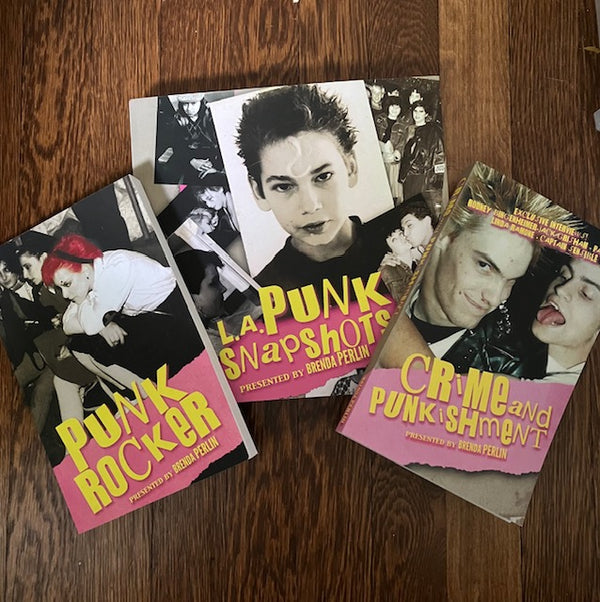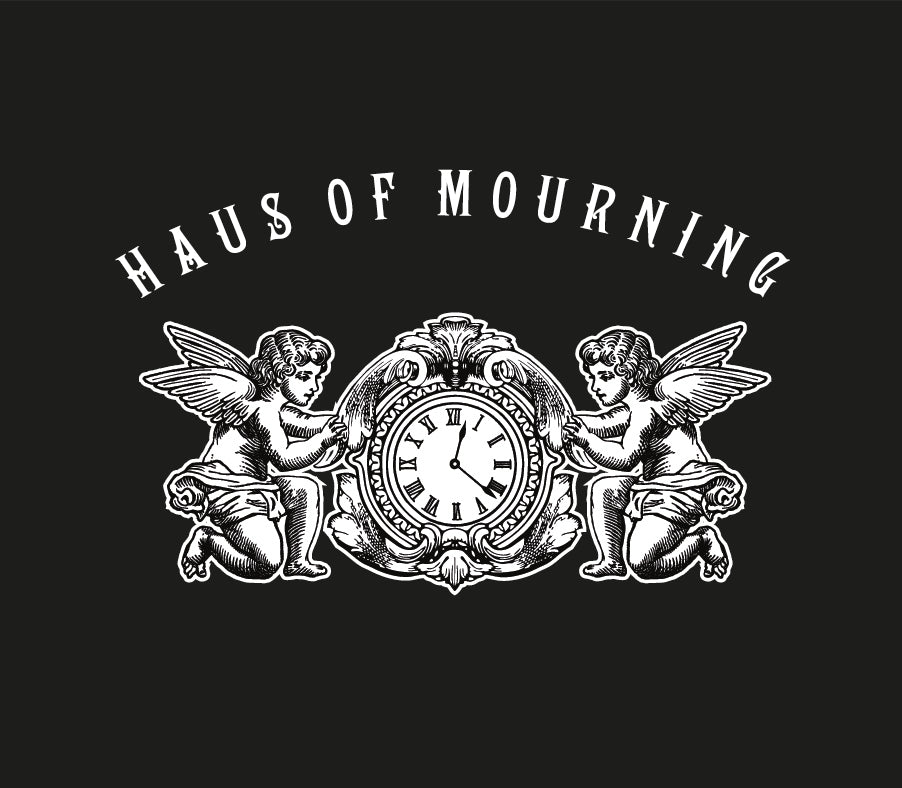
An Interview with L.A.’s Punk Rocker, Brenda Perlin
When I started Haus of Mourning, I wanted to combine my passion projects and job into one. During COVID, I sadly had lost the energy and enthusiasm to keep Women in Rock Magazine going. However, I wasn’t ready to let go of journalism yet. It was complete luck that one of my first clients for Haus of Mourning was Brenda Perlin… 
Being the curious person I am, I wanted to know how Brenda found Haus of Mourning. She said through Instagram and told me she is @lapunkrocker and @losangelespunkrocker. Of course, this piqued my interest and I quickly discovered that not only does she run an amazing account that features videos, photos and information on great punk bands but she is also a writer. Brenda has written Shattered Reality (The Brooklyn and Bo Chronicles that features 2 books), and written/compiled Punk Rocker, L.A. Punk Rocker, L.A. Punk Snapshots and Crime and Punkishment.
Isabelle Helle: What was it like to grow up in LA?
Brenda Perlin: I’m a Valley Girl so I grew up by the Galleria by Val Surf in the Valley with all the surfer dudes. Everybody was very clean cut, you didn’t have tattoos, you didn’t see alternative clothing, no one wore straight legged pants. When you did, you stuck out. It was such a different time, now everybody looks alternative. [Back then] you were judged if you looked a little bit different and that made me want to look even more different. I definitely wanted to stand out more because I liked the look.
IH: What made you get into punk music?
BP: I was around 15 or 16 and I saw the Talking Heads at the Stardust Ballroom and I don’t even know if I dressed at all punk looking. I remember being at the Capitol Records swap meet and I had just heard about Darby Crash and Darby Crash had just died not very long before. I was late but the scene was still happening…There was always something going on and we did feel included, it was very inclusive.
IH: What did your parents think about you being out almost every night?
BP: They hated it. My mom kinda protected me from my dad because my dad had a temper. If he knew what I was doing and where I was going he would have gone crazy. But my mom, she would show up at the Whisky or the Starwood, she’d be wearing her coat and jammies underneath and a babushka on her head and people would say, ‘your mom is here’ and I would say, ‘no’ and she would come in wherever I was and I would hide and I’d either get hauled out or she would go home but she wouldn’t let me stay. Well, sometimes she would let me stay. She worried about me, my parents were strict... So [at] the Starwood, I usually had to leave by like 9/9:30 before things even got started because it was a Tuesday night and I had to go to school so there were a lot of limitations.
 IH: You’ve written a group of fiction books, tell me about those. Is Homewrecker the first fiction novel you wrote?
IH: You’ve written a group of fiction books, tell me about those. Is Homewrecker the first fiction novel you wrote?
BP: That was my first book and I changed the name… I got so much flack from especially women because it’s a sensitive subject, I’m talking about divorce and the other woman which I was the other woman. It’s actually based on a true story but I got a lot of flack and I got tired of it so I changed the title. You learn a lot when you publish a book with criticism and putting yourself out there. It was good and bad. I changed the title to Shattered Reality. It talks about [how] things don’t work out the way you plan. I was married for 15 years and I wrote about that especially when I was going through an ugly divorce. I was going through such a low time that the thing that saved me was writing. Getting that book out and going through it was really helpful. I learned the book business a little bit. And then my friend who is an incredible writer, Mark Barry, he’s from the UK, he’s the one who said to me, ‘you know you should really write about the punk days’ and I said ‘I don’t want to go there, I don’t even know if I remember anything from the punk days’ but he’s the one who gave me the inspiration to go there. I’m so grateful to him because it’s opened up such an avenue, I mean people that I haven’t talked to in 35/40 years have come back into my life just from the books and I’m grateful for that. It’s been so much fun getting back to that and going back to the place that really wakes me up, excites me.
IH: It’s funny you mention Mark Barry because I wrote down from the acknowledgements of Punk Rocker that you said, “He gave me the motivation to go back to my punk days, something I wasn’t sure I wanted to do…” Why were you hesitant about it?
BP: Because people are critical and they are also very passionate about those days so if you get anything inaccurate you’re really going to get slammed. I’ve had a few things like getting the location of the Troubadour wrong or certain dates so I was really concerned, I wanted to do it right and I didn’t want to anger people. So I didn’t think maybe that I had a voice, I wasn’t a musician, I wasn’t the in-crowd. I was just a young goofy girl that was a part of something so I thought, who am I to write about it? What I like is because it’s not all my stories, I like that we’re showing different experiences and I see from all the different stories included that we all had so much in common. Even people that didn’t live in California but especially during those years the experience being an outcast and being ridiculed for looking different, listening to [a] different kind of music, being a little off-beat, it’s really been bonding and healthy. I’m really glad I went there but it’s a big responsibility to write a punk book well.
IH: How did you collect the people for the books? Were they people you already knew? How did you source them?
BP: Some people I didn’t know at all, I just started putting the word out. If you read LA Punk Rocker, it only has a few other stories from other people because at that time, I really didn’t know anybody on Facebook or I wasn’t doing Instagram and I wasn’t doing Twitter. I knew very few people and it was very hard to get people to write because most punks will say ‘oh I’m not a writer, I don’t write’ and meanwhile anyone can write, you just have to sit down and do it. It was hard, so that first book was kind of a trial and I failed miserably but I put it out there and I kinda like the book because of the innocence but I like the latest book because I hope that every time you get better. I think with Crime and Punkishment it’s on the road to something more that I wanted to represent me and the punk scene.

Photo of Brenda at Oki Dog by Fer Youz
IH: What was your go-to punk look during back then?
BP: I would do it different now if I could. I mean, Siouxsie Sioux was the big inspiration with spiky hair, dark eyes. I loved the thrift store little dresses with of course Creepers and Let It Rock had the great bondage pants and a lot of army surplus. I can’t say that I was very pretty, I wore my hair super short, really spiky. I dyed it blue/black and I would put pineapple coconut juice in it sometimes to spike it… clothes were very, very important. Before we went out we had to have our look together. My parents would say, ‘why would you go out of your way to make yourself look ugly?’ I didn’t think it was ugly and I thought all the people were beautiful… It was such a great time in history as far as the look and the fashion. Fashion is still important to me now to this day.
 IH: What’s next for you? Are you working on your next book?
IH: What’s next for you? Are you working on your next book?
BP: Probably my last book, it’s going to be called Punks and it’s almost done. I’m on the edge, I’m waiting for Tom DeSavia who was involved with the John Doe books, he’s amazing too. He was really kind to write for me for Crime and Punkishment and I hope to get another story from him, so I’m waiting on a couple more people and then I’m going to let it out. I don’t know that I’ll do another book, I kind of feel like I’ve done it. But this next one I’m having a really good time with and I think people will enjoy it and we’ll see where it takes me.
IH: This is a hard question but is there a favorite show you’ve been to?
BP: The Damned played at Godzilla’s, that was amazing. I mean there’s so many, Siouxsie Sioux, The Clash, I don’t know if there was a stand out. They weren’t big gigs, they were small shows. I mean the Go-Go’s even, at the Starwood. They were kind of punkish back then. Stiv Bators at the Starwood, oh my god, where he’s hanging himself from the ceiling with his microphone… The Cramps! They would do shows for Halloween.
IH: You’ve gotten to spend time with Billy Idol, Iggy Pop, so many people, is there someone you still keep in touch with? Who’s been nice through this process?
BP: Who’s nicest to me has really been Captain Sensible. Whose nicest to me has really been Captain Sensible. He’s been so kind to me, invited me to shows, given me restaurant recommendations in London, although Billy Zoom has been really generous as well as Linda Ramone and Jack Grisham and I’m so jealous of everyone who’s gotten to see Iggy Pop lately because I hope while he’s still doing his thing I get to see him. When we saw him back in the day we were like little girls. That story was true, he was really nice to us, he was a good guy and he didn’t have to be because we were stupid little girls and he was really kind to us. He made us feel like we were equal… I’m really grateful for my experiences with many people in the scene.
IH: Any last words on punk?
BP: Today being a "punk" is trendy and actually praised. Back in the day PUNK was pretty much a dirty word. We were treated badly (spit on, teased, laughed at and emotionally abused) for expressing our individuality and offbeat style along with our alternative music tastes. People tell me all the time how lucky I was to be a part of the early scene but at the time many of us didn't feel so lucky. We suffered for a cause that I am still fighting for today.
Stay tuned for Brenda Perlin’s next book, Punks, due out this year. And make sure to follow her on Instagram for amazing punk content: @losangelespunkrocker.

